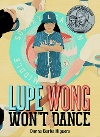Profile of 2022 Newbery Medal winner Donna Barba Higuera
This has been a notorious year of attempts to ban children’s books by authors of color. But 2022 is also the year that Donna Barba Higuera’s middle-grade novel The Last Cuentista won the Newbery Medal. Celebrating a novel that explores stories as a human imperative is the perfect counterpoint to censorship.
 This has been a notorious year of attempts to ban children’s books by authors of color. But 2022 is also the year that Donna Barba Higuera’s middle-grade novel The Last Cuentista won the Newbery Medal. Celebrating a novel that explores stories as a human imperative is the perfect counterpoint to censorship.
This has been a notorious year of attempts to ban children’s books by authors of color. But 2022 is also the year that Donna Barba Higuera’s middle-grade novel The Last Cuentista won the Newbery Medal. Celebrating a novel that explores stories as a human imperative is the perfect counterpoint to censorship.
Set in a future just before Halley’s comet collides with Earth, The Last Cuentista stars a young storyteller who is hustled aboard a spaceship with her family and other refugees in an attempt to save humanity. While The Last Cuentista looks to the future, its roots reach back to the small California town where Higuera grew up. Two hours northwest of Los Angeles, Taft sits atop a cauldron of petroleum and natural gas. It’s a single-stoplight town with a defunct railroad station where a sign once offered a cruel warning to people of color. The gist: “You’d best leave before dark.”
When Higuera was a child, Taft was a sundown town, a name that comes from the threats white residents would make to workers and visitors. Higuera, who is biracial, says it was hard to grow up in a place like that. “No one ever said out loud who were members of the Klan or if it still existed in the shadows, but there was this layer of fear that was always present.” In 1975, there was even a near-lynching of Black junior college football players caused by outrage over an interracial romance.
This grim atmosphere made its way into The Last Cuentista, where the villains are humans who’ve modified their skin, leaching it of color. The layer of fear they create aboard the spaceship is palpable, and their see-through skin is a stark contrast to the beautiful brown skin of the hero, a girl named Petra who finds herself and her power through storytelling. (Petra is a particularly funny cuentista: she thinks the bad guys look like ambulatory prawns.)
As much as Higuera was surrounded by the evil of racism in her hometown, she was also wrapped in love and story, and these, too, flowed into the novel. “That opening scene was very emotional for me to write,” Higuera says. “I was transported back in time into the arms of my own grandmother. Their conversation was our conversation. Lita’s story to Petra was my grandmother speaking to me.” And it wasn’t just her grandmother telling her stories. They also came from her father, an elderly neighbor, and Higuera’s mother, whose tales centered the magic and hardships of her own childhood on a farm in Oklahoma.
Protected by love and story, young Donna relished burying bottle caps and broken jewelry, her treasures. She collected garden snails in empty mayonnaise jars. She rescued cats and dogs — sort of. “My parents had to check with neighbors to make sure their pets weren’t missing,” Higuera says.
She shared a bedroom with her sister in their tiny, nine-hundred-square-foot house, and that’s where Donna built forts between her bed and the window. There, she’d fill herself with more stories. And the stories couldn’t help but burst forth. “I would tell anyone, including strangers, my fantastical tales.”
* * *

Young Donna with her family, "protected by love and story."
Photos courtesy of Donna Barba Higuera.
Even though her mother was a kindergarten and first-grade teacher, she didn’t quite understand why Higuera was spending so much time on books and writing as an adult. By then, Higuera had become an optometrist with a thriving practice in a suburb of Seattle. She was married with four children, three dogs, and two frogs (all acquired legitimately).
But the grown-up Higuera couldn’t help but write. C. S. Lewis’s The Lion, the Witch and the Wardrobe had blown her mind and turned her into a reader when she was small. Meg Murry in A Wrinkle in Time inspired Higuera to be brave despite her perceived flaws. And when she read Pam Muñoz Ryan’s Esperanza Rising as an adult, she encountered a character like herself on the page for the first time. That story rang true to her grandmother’s tales, and it felt like a revelation of what was possible.
 So when she was in her forties, she set out to write seriously, and in 2011 drafted her first novel. That manuscript became Lupe Wong Won’t Dance, a hilarious contemporary middle-grade novel that combined Higuera’s childhood love of baseball with her loathing of square dancing. By the time the book was finished, Higuera’s mother was very ill. And she still wasn’t sure about her daughter’s creative choice. “When I told her the premise, she said, ‘Oh, Donna. You’re going to ruin square dancing for everyone.’”
So when she was in her forties, she set out to write seriously, and in 2011 drafted her first novel. That manuscript became Lupe Wong Won’t Dance, a hilarious contemporary middle-grade novel that combined Higuera’s childhood love of baseball with her loathing of square dancing. By the time the book was finished, Higuera’s mother was very ill. And she still wasn’t sure about her daughter’s creative choice. “When I told her the premise, she said, ‘Oh, Donna. You’re going to ruin square dancing for everyone.’”
Higuera sat by her mother’s sickbed and read the story to her. Her mother was weak and would close her eyes and breathe deeply as she listened. Higuera kept thinking that her mom had drifted off, but when she’d set down her laptop, her mother would nudge her to continue. “The entire time I read, I worried what she would think. Would she understand that this book had nothing to do with ruining square dancing and was meant to be so much more than that one little thing?” When Higuera finished reading, her mother smiled. “Okay,” she said quietly. “I get it.”
She was gone two weeks later.
“With time,” Higuera said, “I’ve come to realize that the I get it referred to so much more than that one book.”
 Lupe Wong Won’t Dance won a Pura Belpré Children’s Author Honor and the Sid Fleischman Humor Award. Next published was Higuera’s debut picture book, El Cucuy Is Scared, Too! And then came The Last Cuentista, which first emerged as a short story based on a writing prompt: take a traditional fairy tale and make it sci-fi.
Lupe Wong Won’t Dance won a Pura Belpré Children’s Author Honor and the Sid Fleischman Humor Award. Next published was Higuera’s debut picture book, El Cucuy Is Scared, Too! And then came The Last Cuentista, which first emerged as a short story based on a writing prompt: take a traditional fairy tale and make it sci-fi.
In that brief short story, a “generic” girl is put into a cryogenic state for a journey across the universe. When her PEA — pellet of extended animation — fails, she never truly sleeps and emerges after centuries of wakefulness into a society that has changed and a form of humanity that is unrecognizable. Everything the girl had valued has been destroyed.
The premise haunted Higuera for years, and when it came to working on a second novel with Levine Querido editor Nick Thomas, this is the one she chose. As she worked, the core story question remained. If humans were traveling to another planet, what would they take with them? What would each person value? What if someone threatened that?
Higuera’s protagonist is anything but generic. Petra is a person of color and she is visually impaired. It makes her more vulnerable in myriad ways, and the idea came from one of Higuera’s first medical diagnoses, made when she was practicing with her new clinical tools in graduate school. She was looking into her mother’s eyes and noticed something shocking: a condition called retinitis pigmentosa, a genetic disorder that causes vision loss and worsening tunnel vision. Before this, Higuera’s mother had never been diagnosed.
“When I pressed my mom further, she said she knew from a young age that she didn’t see like others. But she was determined not to let it control her life,” Higuera says. “She was living with the impairment, and many didn’t even know. So while Petra has retinitis pigmentosa, I don’t let it control the narrative of her goals and what she must accomplish, much like my mother. It’s not all of who Petra is.”
This rich complexity is Higuera’s forte. The Last Cuentista is rooted in a classic, if often overlooked, fairy tale, “The Princess and the Pea.” It’s also science fiction. It’s dark. And it’s full of humor and hope. All of this is by design.
“Pummeling young readers over the head with too much action, or death, or sadness is overwhelming,” she says. “Balancing tears with some laughter is an important goal for me as a writer. Even in my everyday life, I have to balance the sad with the funny.”
She never imagined, as she was writing, that more awards were in her future (the book won the 2022 Pura Belpré Children’s Author Award in addition to the Newbery). Nor did she imagine that what she was writing about — the erasure of stories — would come to pass as it has in 2022.
“This is horrifying,” she says. “And it is happening.”
It is happening, but the kind of spotlight the Newbery Medal puts on winners ensures that a generation of children will read about a biracial child with a disability who keeps the best parts of us alive with stories. They will read, they will remember, and, like Higuera, they will write.
From the July/August 2022 issue of The Horn Book Magazine: Special Issue: ALA Awards. For more speeches, profiles, and articles, click the tag ALA 2022.
 Single copies of this special issue are available for $15.00 including postage and may be ordered from:
Single copies of this special issue are available for $15.00 including postage and may be ordered from:
Kristy South
Administrative Coordinator, The Horn Book
Phone 888-282-5852 | Fax 614-733-7269
ksouth@juniorlibraryguild.com

RELATED
ALREADY A SUBSCRIBER? LOG IN
We are currently offering this content for free. Sign up now to activate your personal profile, where you can save articles for future viewing.







Add Comment :-
Be the first reader to comment.
Comment Policy:
Comment should not be empty !!!